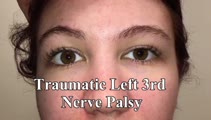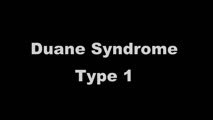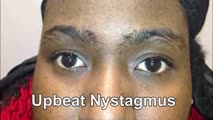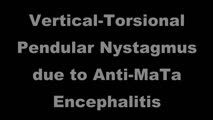A collection of videos relating to the diagnosis and treatment of eye movement disorders. This collection includes many demonstrations of examination techniques.
Dan Gold, D.O., Associate Professor of Neurology, Ophthalmology, Neurosurgery, Otolaryngology - Head & Neck Surgery, Emergency Medicine, and Medicine, The Johns Hopkins School of Medicine.
A collection of videos relating to the diagnosis and treatment of eye movement disorders.
NOVEL: https://novel.utah.edu/
TO
Filters: Collection: ehsl_novel_gold
| Title | Description | Subject | ||
|---|---|---|---|---|
| 201 |
 |
Torsional Jerk Nystagmus | Presented here are 3 patients with torsional jerk nystagmus. The first patient presented with vertigo and experienced oscillopsia due to her torsional nystagmus. Pure or predominantly torsional nystagmus is highly suggestive of a central process. Her nystagmus was unidirectional and followed Alexand... | Medulla; Cerebellar; Jerk Nystagmus; Rotary Nystagmus |
| 202 |
 |
Torsional Nystagmus Due to Medullary Pilocytic Astrocytoma | 𝗢𝗿𝗶𝗴𝗶𝗻𝗮𝗹 𝗗𝗲𝘀𝗰𝗿𝗶𝗽𝘁𝗶𝗼𝗻: This is a 30-year-old woman who experienced headaches which led to an MRI and the diagnosis of a right medullary pilocytic astrocytoma, confirmed pathologically. Examination was performed a year after the initial diagnosi... | Jerk Nystagmus; Rotary Nystagmus; OMS Medulla |
| 203 |
 |
Traumatic 3rd Nerve Palsy with Aberrant Regeneration | 𝗢𝗿𝗶𝗴𝗶𝗻𝗮𝗹 𝗗𝗲𝘀𝗰𝗿𝗶𝗽𝘁𝗶𝗼𝗻: This is a 20-yo-woman who experienced severe head trauma and diplopia upon awakening from a coma several weeks after the injury. She had a partial left 3rd nerve palsy (adduction spared), and when she looked to the right ... | Third Nerve Palsy; Third Subnuclear Palsy; Aberrant Regeneration |
| 204 |
 |
Triangle of Guillain-Mollaret | Seen here is a schematic representation of the Gullain-Mollaret triangle (Figure 1), also referred to as the dentato-olivary pathway, reflecting the 3 points of this imaginary triangle - 1) dentate nucleus, 2) red nucleus, and 3) inferior olivary nucleus. The olive sends decussating climbing fibers ... | Pendular Nystagmus; Oculopalatal Tremor |
| 205 |
 |
Trigeminal, Facial (with Aberrant Regeneration), and Vestibulocochlear Nerve Palsies Following Tumor Resection | This is a 30-yo-woman who underwent resection of a right trigeminal schwannoma. Post-operatively, she was vertiginous with a clearly + head impulse test to the right (and spontaneous left-beating nystagmus), had lost hearing in the right ear, had no facial sensation on the right, and had a right low... | Vestibulo-ocular Reflex and Head Impulse Testing Abnormal; Facial Nerve |
| 206 |
 |
Two Patients with Parinaud's Syndrome with Slow Upward Saccades and Normal Upward Range of Movements | Presented here are two patients with Parinaud's syndrome: Patient 1) suffered a hemorrhage of the dorsal midbrain causing slow upward saccades (with convergence retraction nystagmus, but normal vertical range of eye movements), and light-near dissociation, and Patient 2) had a germinoma of the dorsa... | Abnormal Saccades; Dorsal Midbrain; Jerk Nystagmus; Gaze Evoked Nystagmus |
| 207 |
 |
Typical Features of Duane Syndrome Type 1 | 𝗢𝗿𝗶𝗴𝗶𝗻𝗮𝗹 𝗗𝗲𝘀𝗰𝗿𝗶𝗽𝘁𝗶𝗼𝗻: This is a patient seen for vestibular complaints, who on exam, was found to have (unrelated to her vestibular symptoms) impaired abduction OS. In adduction, there was narrowing of the palpebral fissure OS, a result of glo... | Abnormal Range; Duane Syndrome; Sixth Nerve Palsy |
| 208 |
 |
Typical Lid Signs (Cogan's Lid Twitch, Lid Hopping, Enhanced Ptosis) in Myasthenia Gravis | 𝗢𝗿𝗶𝗴𝗶𝗻𝗮𝗹 𝗗𝗲𝘀𝗰𝗿𝗶𝗽𝘁𝗶𝗼𝗻: This is a 60-yo-woman with MG who displays typical eyelid signs including Cogan's lid twitch, lid hopping (appreciated during horizontal smooth pursuit in this patient), and enhanced ptosis in accordance with Hering's law... | Myasthenia Gravis |
| 209 |
 |
Unidirectional Nystagmus in Lateral Medullary Syndrome | This is a 70-yo-man who presented with acute vertigo. Examination demonstrated very mild spontaneous torsional nystagmus (towards the right ear) in primary (not seen well in this video), with robust downbeat-torsional (towards right ear) nystagmus in right gaze and (less robust) almost pure torsiona... | Medula; Rotary Nystagmus; Jerk Nystagmus; Acute Vestibula; Vestibular Nystagmus; Abnormal Saccades |
| 210 |
 |
Unidirectional Nystagmus Two Days After Onset of Vestibular Neuritis | ||
| 211 |
 |
Unidirectional Vestibular Nystagmus | 60-yo-man with recurrent vertigo attacks - this video was taken during one of his typical attacks, and shows left-beating nystagmus that stayed left-beating in all directions of gaze, more in left gaze (in accordance with Alexander's Law), and less in right gaze. This pattern is more commonly seen w... | Jerk Nystagmus; Vestibular Nystagmus; Vestibulo-ocular Reflex; Head Impulse Testing; Benign Recurrent Vertigo; Migraine Variant |
| 212 |
 |
Unilateral 3rd, 4th, and 6th Nerve Palsies Due to Cavernous Sinus Meningioma | 𝗢𝗿𝗶𝗴𝗶𝗻𝗮𝗹 𝗗𝗲𝘀𝗰𝗿𝗶𝗽𝘁𝗶𝗼𝗻: This is a 50-year-old woman presenting with a partial 3rd nerve palsy (mild pupil involvement), partial 6th nerve palsy, and no clear incyclotorsion with downgaze, suggestive of additional 4th nerve palsy, all on the left... | Abnormal Range; Third Nerve Palsy; Aberrant Regeneration; Fourth Nerve Palsy; Sixth Nerve Palsy; Jerk Nystagmus; Downbeat Nystagmus; Gaze Evoked Nystagmus; Abnormal Saccades |
| 213 |
 |
Upbeat and Downbeat Nystagmus Due to Anti-VGCC Antibodies | Seen here are two patients who presented with imbalance and vertical oscillopsia, the first with upbeat nystagmus, and the second with downbeat nystagmus. Both patients were found to have voltage-gated calcium channel antibodies in serum without evidence of systemic malignancy. The UBN patient had m... | Jerk Nystagmus; Upbeat Nystagmus; Gaze Evoked Nystagmus; Downbeat Nystagmus |
| 214 |
 |
Upbeat Nystagmus & Ocular Flutter Due to Cerebellar Pilocytic Astrocytoma | This is a 20-year-old woman who was diagnosed with a cerebellar pilocytic astrocytoma at age 10 after presenting with severe headaches and hydrocephalus. She underwent incomplete resection and radiation therapy at that time. She experienced mild vertical oscillopsia in upgaze at baseline, and increa... | Upbeat Nystagmus; Ocular Flutter |
| 215 |
 |
Upbeating and Gaze-evoked Nystagmus, V-pattern Esotropia from Bilateral 4th Nerve Palsies | Video example of a patient with upbeating and gaze-evoked nystagmus, V-pattern esotropia from bilateral 4th nerve palsies. | Upbeat Nystagmus; Gaze Evoked Nystagmus; Fourth Nerve Palsy |
| 216 |
 |
Using Video Head Impulse Testing to Unmask Covert Saccades in Compensated Vestibular Neuritis (Figures 1 and 2) | This is a 30-year-old woman who experienced the acute vestibular syndrome (prolonged vertigo for >24 hours, nausea, unsteadiness, spontaneous nystagmus, head motion intolerance) and was diagnosed with vestibular neuritis. This diagnosis was based on a positive head impulse test to the left (see Figu... | VOR Normal; VOR Abnormal |
| 217 |
 |
Using Video Head Impulse Testing to Unmask Covert Saccades in Compensated Vestibular Veuritis | This is a 30-year-old woman who experienced the acute vestibular syndrome (prolonged vertigo for >24 hours, nausea, unsteadiness, spontaneous nystagmus, head motion intolerance) and was diagnosed with vestibular neuritis. This diagnosis was based on a positive head impulse test to the left (see Figu... | VOR Normal; VOR Abnormal |
| 218 |
 |
The Utriculo-Ocular Motor Pathways - Physiologic and Pathologic Ocular Tilt Reaction: OTR Diagram Pathologic EOMs Labelled (Figure 3) | A skew deviation is a non-paralytic vertical ocular misalignment that is due to imbalance in the utriculo-ocular motor pathways. While vestibular jerk nystagmus is a consequence of static semicircular canal pathway imbalance (e.g., left-beating nystagmus due to acute right vestibular hypofunction fr... | Skew Deviation |
| 219 |
 |
The Utriculo-Ocular Motor Pathways - Physiologic and Pathologic Ocular Tilt Reaction: Pathologic OTR (Figure 2) | A skew deviation is a non-paralytic vertical ocular misalignment that is due to imbalance in the utriculo-ocular motor pathways. While vestibular jerk nystagmus is a consequence of static semicircular canal pathway imbalance (e.g., left-beating nystagmus due to acute right vestibular hypofunction fr... | Skew Deviation |
| 220 |
 |
The Utriculo-Ocular Motor Pathways - Physiologic and Pathologic Ocular Tilt Reaction: Physiologic Ocular Tilt Reaction (OTR) (Figure 1) | A skew deviation is a non-paralytic vertical ocular misalignment that is due to imbalance in the utriculo-ocular motor pathways. While vestibular jerk nystagmus is a consequence of static semicircular canal pathway imbalance (e.g., left-beating nystagmus due to acute right vestibular hypofunction fr... | Skew Deviation |
| 221 |
 |
Vertical Semicircular Canal Pathways | Anterior Canal Pathway Afferents that originate in the anterior canals (AC) of the peripheral labyrinth first synapse in the ipsilateral vestibular nucleus. Three pathways exist: 1) medial longitudinal fasciculus (MLF) - right AC afferents to right medial vestibular nucleus (MVN), decussate and asc... | Anterior Canal Pathway; Posterior Canal Pathway |
| 222 |
 |
Vertical-Torsional Pendular Nystagmus and Convergence Spasm Due to Anti-MaTa Encephalitis | This is a 50-yo-woman with debilitating oscillopsia due to a high frequency (6 Hz) vertical-torsional pendular (quantitative eye movement recordings were performed) nystagmus. She also had intermittent double vision due to (organic) convergence spasm. Her nystagmus and spasm were thought to be relat... | Mesencephalon; Pendular Nystagmus; Convergence Spasm |
| 223 |
 |
Vestibular Neuritis with a Peripheral Skew Deviation | 𝗢𝗿𝗶𝗴𝗶𝗻𝗮𝗹 𝗗𝗲𝘀𝗰𝗿𝗶𝗽𝘁𝗶𝗼𝗻: This is a 55-year-old hypertensive man who developed acute onset continuous vertigo and presented to the Emergency Department (ED) after several hours of symptoms. He was noted to have spontaneous nystagmus and had a nor... | Abnormal VOR; Abnormal Alignment; Eighth Nerve; Skew Deviation; Lateropulsion; Jerk Nystagmus; Vestibular Nystagmus; Acute Vestibular Syndrome |
| 224 |
 |
Vestibulocerebellum Lecture | A lecture on vestibulocerebellum. | Vestibulocerebellum |
| 225 |
 |
Vibration and Hyperventilation-induced Nystagmus from Vestibular Schwannoma | 𝗢𝗿𝗶𝗴𝗶𝗻𝗮𝗹 𝗗𝗲𝘀𝗰𝗿𝗶𝗽𝘁𝗶𝗼𝗻: This is a 50-yo-woman with imbalance, and with fixation removed on her examination (with Frenzel goggles), there was no spontaneous nystagmus. Using a handheld vibrator to vibrate the mastoids and vertex, there was a righ... | Jerk Nystagmus; Vestibular Nystagmus; Hyperventilation |
